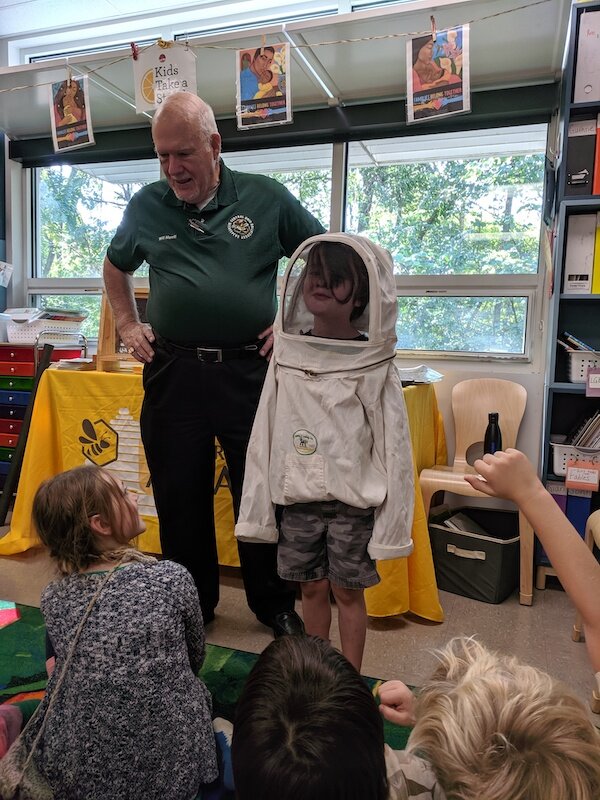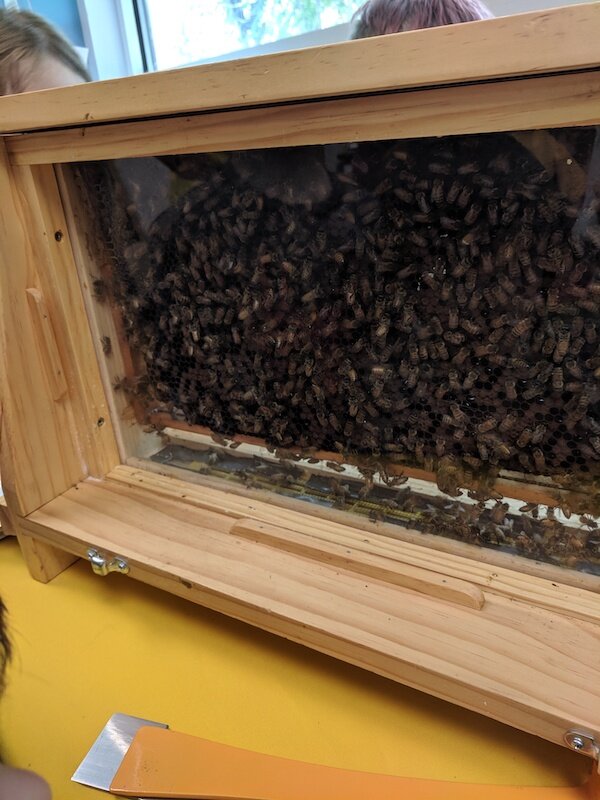Our Chicakdees LOVE Bees
Each mixed-age class at Red Oak is named for a bird that can be found in our local landscape. Our youngest (Kindergarteners) are called Chickadees. And like their namesake, they are small and sweet, active and adventurous, but also curious and complex.
This fall, they have been studying bees alongside their teacher, Michelle McNabb. This is Michelle’s third year at Red Oak. I remember when she interviewed for the job I was blown away by her sample lessons. She wove literature and language, observation and discovery together seamlessly. I was so enamored I considered holding my daughter back to repeat kindergarten so she could have Michelle as a teacher. It’s a pleasure to watch her work from afar.
Michelle embarked on the bee study after noticing the kids’ reactions to bees during lunches outside. She told me that, “the kids were worried, scared and anxious as bees flew around them and/or their lunches. Several students would yell or cry and/or quickly get up to move or run away. I figured learning about bees would help us understand them and be less fearful. Also, I decided to focus on honey bees because who doesn't like honey?”
They started by working together to list everything they knew about honey bees. They read In the Trees, Honey Bees!, and then added new information learned to their list. As she read the story, Michelle noticed that the kids enjoyed the rhyming words and she lead them to make predictions about what the next rhyming word might be.
Outside they played a honey bee game: worker bees or "scouts" flew out of the hive to find and collect pollen and nectar, then returned to the hive to perform a bee dance so the other worker bees would know where to fly to collect pollen/nectar. As they played, they discovered and observed bees collecting from flowers. They did a similar activity indoors in which they practiced fine motor skills during which one student exclaimed, "Now I know why they are called worker bees...this is lots of work!"
A highlight of the unit was a visit from beekeeper Will Merrill of Orchard Lane Apiary just a mile and a half down the road from school. He brought a thousand of his honey bee friends with him. The Chickadees (and the next older class, the Sparrows) asked Mr. Merrill a lot of questions and learned a lot. They followed this visit up with a walk to OTFUF (Over the Fence Urban Farm) where, in addition to exploring what was still growing and meeting the chickens, they looked around for bees enjoying the final flowers of fall.
The bee buzzer science project was a favorite as the Chickadees experimented with materials to make a buzzing bee sound. They discovered that wide rubber bands produce a much louder sound than narrow rubber bands. In another sensory activity related to their studies, Chickadees looked at the world through eyes of bees as they discovered bees' compound eyes and colors they see. Chickadees used a special lens to see like a bee as images became fractured like a mosaic which led to a flower mosaic art project.
After reading and reflecting on What If There Were No Bees? and Give Bees a Chance, Chickadees imagined the world without bees and then made signs to encourage others to think about the importance of bees.
They rounded out their studies with a honey tasting activity in which they tried three different varieties - talking about the differences they noticed in taste, smell, and color. And finally, they planted seeds in the Red Oak garden that will grow into pollinator-friendly perennials including bee balm and coneflower. As Michelle told me, “I also wanted the kids to know the importance of bees as pollinators, as part of the food chain, and the huge impact they have on what we eat every single day.”
To me - as a professional educator, homeschooling parent, and Red Oak Board member - this unit “hit all the buttons.” It was interdisciplinary, interactive, had real world connections, produced original artwork, and stretched out over a length of time that allowed the topic soak in to students minds. Seeing the unit come to an end, I was compelled to ask Michelle a bit about her experience teaching it.
As I suspected based on my own teaching experiences, Michelle reported that she learned a lot right alongside her students. “I didn't know about the bee dance workers perform to tell other bees where to find nectar sources, nor did I know about the many jobs, besides the obvious, collecting nectar, making honey, that worker bees have (nurse, guard, air conditioner, etc). Also I enjoyed learning more about the bees' process of making honey as well as how beekeepers collect honey. So much so that I plan on taking the beekeeper class this winter.”
I can’t wait to see what they dig into next.
Jodi Kushins, ROCS Blogger
(with help from class notes kept by Michelle McNabb)





